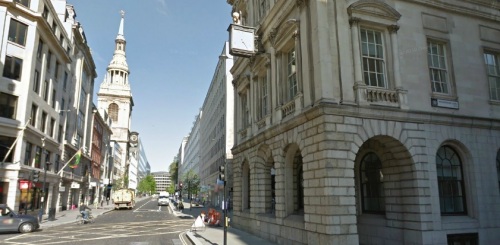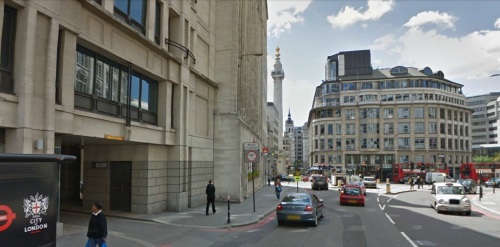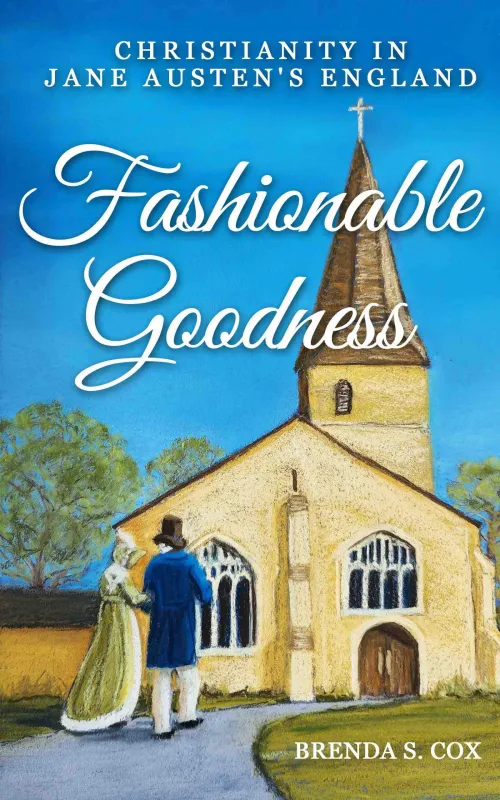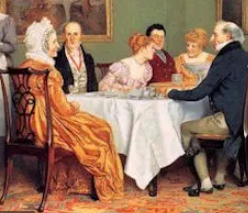Inquiring readers: This is the first of many posts I’ll be writing about “Pride and Prejudice” in honor of that novel’s 200 year anniversary in 2013. Enjoy.
Some London streets seem determined never to distinguish themselves. No mediaeval scuffle has ever occurred in them; no celebrated church hoards its monuments; no City hall cherishes its relics there; no celebrated person has honoured it by birth or death. Gracechurch Street is one of these unambitious streets. It derived its name, says Stow, from the grass or herb market there kept in old time, and which gave its name to the parish church of St. Bennet. – British History Online,
It is a woeful fact that I most likely crossed Gracechurch Street on my first visit to London and never new it. We had just visited Tower Hill and were heading for St. Paul’s Cathedral on foot. My husband and I wandered here and there and got lost, no nearer to our destination. This part of London seemed a mismash of old and mostly modern buildings, with wide and narrow streets, some twisting and winding, others straight. It was nothing like the old London my 24-year-old self had expected to see, for at that time I did not fully realize the extent of the devastation that the great fire of 1666 had wrought. Those changes were compounded by the London Blitz during WWII and recent modernization.

Early modern map of Cheapside. Image @The Map of Early Modern London One can see Bow Church at the top center.
We finally boarded a transit bus and missed noticing Gracechurch Street. Not that I would have searched for it. At that time I would not have recalled the few references in Pride and Prejudice to the street where Lizzy Bennet’s aunt and uncle Gardiner lived.
Mr. Gardiner was a sensible, gentlemanlike man, greatly superior to his sister, as well by nature as education. The Netherfield ladies would have had difficulty in believing that a man who lived by trade, and within view of his own warehouses, could have been so well bred and agreeable. Mrs. Gardiner, who was several years younger than Mrs. Bennet and Mrs. Philips, was an amiable, intelligent, elegant woman, and a great favourite with all her Longbourn nieces. Between the two eldest and herself especially, there subsisted a very particular regard. They had frequently been staying with her in town.
The first part of Mrs. Gardiner’s business on her arrival, was to distribute her presents and describe the newest fashions.
I love the Gardiners, two sane people in a novel filled with characters and oddballs. They provide ballast and sound advice to Elizabeth, who wisely turned to Mrs. Gardiner, not her mother, when mulling a problem about love and life. Mr. Gardiner was a merchant who lived close to his warehouse. Despite their middle class background, the Gardiners are more refined and sensible than many of their social betters. Elizabeth is proud to introduce them to Mr. Darcy when visiting his estate, knowing that their restrained behavior would not make him (or her) cringe.

Cheapside in the mid 18th century. Image @Republic of Pemberley
Caroline Bingley, whose snobbishness was evident when she paid Jane a hasty courtesy call at Gracechurch Street, demonstrated a decided lack of class when she all but wrinkled her nose at a neighborhood she had probably managed to avoid all her life, an interesting attitude considering her family’s wealth came from trade and she was but one generation away from the “stench” of the merchant class. Social calls, their timing and length – or lack thereof – could be used to extend a friendship or give the cut direct, which in this instance Miss Bingley chose to do to Jane. Her lack of civility and coolness before and during the visit finally opened Jane’s eyes to Caroline’s desire to end their friendship. This was an event that Mrs. Gardiner and Lizzy correctly predicted beforehand:
Chapter 25: [Mrs. Gardiner] Poor Jane! I am sorry for her, because, with her disposition, she may not get over it [her failed love affair with Bingley] immediately. It had better have happened to you, Lizzy; you would have laughed yourself out of it sooner. But do you think she would be prevailed on to go back with us? Change of scene might be of service — and perhaps a little relief from home, may be as useful as anything.”
Elizabeth was exceedingly pleased with this proposal, and felt persuaded of her sister’s ready acquiescence.
“I hope,” added Mrs. Gardiner, “that no consideration with regard to this young man will influence her. We live in so different a part of town, all our connexions are so different, and, as you well know, we go out so little, that it is very improbable they should meet at all, unless he really comes to see her.”
“And that is quite impossible; for he is now in the custody of his friend, and Mr. Darcy would no more suffer him to call on Jane in such a part of London! My dear aunt, how could you think of it? Mr. Darcy may, perhaps, have heard of such a place as Gracechurch Street, but he would hardly think a month’s ablution enough to cleanse him from its impurities, were he once to enter it; and, depend upon it, Mr. Bingley never stirs without him.”
“So much the better. I hope they will not meet at all. But does not Jane correspond with the sister? She will not be able to help calling.”
“She will drop the acquaintance entirely.”

Dennis Severs house, a Georgian merchant’s house in Spitalsfield. Image @photographs
Roelof Bakker, http://www.rbakker.com
“…lessen their chance of marrying men of any consideration in the world.“
With this phrase, Austen gives us a clue about the Bennet girls’ situation, but, as we know, the ending of Pride and Prejudice proves this forecast wrong (for Lizzy and Jane, at least).
Lizzy is right about Caroline Bingley, but not about Darcy. In the following scene her prejudice towards that proud man comes to the fore. She assumes that Mr. Darcy’s attitude towards Gracechurch Street will echo that of Caroline Bingley, for this bustling shopping district simply wasn’t an area that the upper crust tended to visit. Caroline, Darcy and Bingley made their observations about the Bennet family during their stay at Netherfield:
“I think I have heard you say that their uncle is an attorney in Meryton”
“Yes; and they have another, who lives somewhere near Cheapside.”
“That is capital,” added her sister, and they both laughed heartily.
“If they had uncles enough to fill all Cheapside,” cried Bingley, “it would not make them one jot less agreeable.”
“But it must very materially lessen their chance of marrying men of any consideration in the world,” replied Darcy.
Darcy, it turns out, is made of finer stuff than Caroline Bingley, for when he visits the Gardiners in his quest to find Wickham, his attitude is anything but snobbish – stubborn, as Mrs. Gardiner later relates, but not snobbish. While arranging Wickham’s marriage to Lydia, he visits Gracechurch Street on several occasions and even dines with the Gardiners, leaving them with a very positive impression of his character:
Chapter 51 [Letter from Mrs. Gardiner to Lizzy after Lydia revealed Darcy’s part in her marriage to Wickham] He dined with us the next day, and was to leave town again on Wednesday or Thursday. Will you be very angry with me, my dear Lizzy, if I take this opportunity of saying (what I was never bold enough to say before) how much I like him. His behaviour to us has, in every respect, been as pleasing as when we were in Derbyshire. His understanding and opinions all please me; he wants nothing but a little more liveliness, and that, if he marry prudently, his wife may teach him. I thought him very sly;—he hardly ever mentioned your name. But slyness seems the fashion.

Mansion House, Cheapside. Image @Darvill’s Rare Prints
At the time that Jane Austen wrote Pride and Prejudice, Cheapside was a very elegant thoroughfare with many sumptuous warehouses, convenient coffee houses, and smart shops. In Real Life in London, Pierce Egan writes a passage in which Tom and Bob walk through this area filled with shopkeepers, bankers, merchants, shoppers, and “walking” billboards:
“Neither,” replied Dashall; “this is no other than the shop of a well-known dealer in stockings and nightcaps, who takes this ingenious mode of making himself popular, and informing the passengers that
“Here you may be served with all patterns and sizes,
From the foot to the head, at moderate prices;”with woolens for winter, and cottons for summer—Let us move on, for there generally is a crowd at the door, and there is little doubt but he profits by those who are induced to gaze, as most people do in London, if they can but entrap attention. Romanis is one of those gentlemen who has contrived to make some noise in the world by puffing advertisements, and the circulation of poetical handbills. He formerly kept a very small shop for the sale of hosiery nearly opposite the East-India House, where he supplied the Sailors after receiving their pay for a long voyage, as well as their Doxies, with the articles in which he deals, by obtaining permission to style himself “Hosier to the Rt. Hon. East India Company.” Since which, finding his trade increase and his purse extended, he has extended his patriotic views of clothing the whole population of London by opening shops in various parts, and has at almost all times two or three depositories for Romanis, the eccentric Hosier, generally places a loom near the door of his shops decorated with small busts; some of which being attached to the upper movements of the machinery, and grotesquely attired in patchwork and feathers, bend backwards and forwards with the motion of the works, apparently to salute the spectators, and present to the idea persons dancing; while every passing of the shuttle produces a noise which may be assimilated to that of the Rattlesnake, accompanied with sounds something like those of a dancing-master beating time to his scholars. his stock. (sic) At this moment, besides what we have just seen, there is one in Gracechurch Street, and another in Shoreditch, where the passengers are constantly assailed by a little boy, who stands at the door with some bills in his hand, vociferating—Cheap, cheap.”
“Then,” said Bob, “wherever he resides I suppose may really be called Cheapside?”
“With quite as much propriety,” continued Ton, “as the place we are now in; for, as the Irishman says in his song,
“At a place called Cheapside they sell every thing dear.”
During this conversation, Mortimer, Merrywell, and Harry were amusing themselves by occasionally addressing the numerous Ladies who were passing, and taking a peep at the shops—giggling with girls, or admiring the taste and elegance displayed in the sale of fashionable and useful articles—justled and impeded every now and then by the throng. Approaching Bow Church, they made a dead stop for a moment.
“What a beautiful steeple!” exclaimed Bob; “I should, though no architect, prefer this to any I have yet seen in London.” – Real Life in London, Egan

Cheapside and Bow Church engraved by W.Albutt after T.H.Shepherd publ 1837 edited. The pretty steeple is visible in this image. (wikipedia)
Once upon a time, Cheapside and Gracechurch Street were in the commercial heart of the city of London. It was the main shopping district in Jane Austen’s day. She describes the journey to Gracechurch street and Lizzy’s visit with the Gardiners in this lively scene:
Chapter 27: It was a journey of only twenty-four miles, and they began it so early as to be in Gracechurch Street by noon. As they drove to Mr. Gardiner’s door, Jane was at a drawing-room window watching their arrival; when they entered the passage she was there to welcome them, and Elizabeth, looking earnestly in her face, was pleased to see it healthful and lovely as ever. On the stairs were a troop of little boys and girls, whose eagerness for their cousin’s appearance would not allow them to wait in the drawing-room, and whose shyness, as they had not seen her for a twelvemonth, prevented their coming lower. All was joy and kindness. The day passed most pleasantly away: the morning in bustle and shopping, and the evening at one of the theatres.

Steel engraving of the Bow Church on Cheapside Street in London (the Bow Church is probably better known as Saint Mary’s Le Bow and it is said that all true Cockneys were born within the sounds of this church’s bells) Image @bouletfermat.com
Gracechurch Street means grass-church and was thus named because of a hay market nearby (1680-1868). The distinctive steeple of St Mary-le-Bow Church is the only structure remaining today that Jane Austen would have recognized. A church has stood on this ground since Saxon times. After the Fire of 1666, Christopher Wren designed a new structure, which was destroyed during a 1941 bombing was and carefully reconstructed during the 1950s. Today, Gracechurch Street largely resembles a modern office block.
In the 17th century, coffeehouses arrived in the City and these soon became the place to pick up news. Some houses became the makeshift offices of the trades they served, giving birth to some of the world’s greatest financial institutions – the London Stock Exchange started in Jonathan’s Coffeehouse in Change Alley and Lloyds of London takes its name from Edward Lloyd, the proprietor of a coffeehouse in Tower Street. This, coupled with the founding by Royal Charter of the Bank of England in 1694, was the catalyst for the development of the City as a financial centre. – History of Cheapside
Cheapside was anything but cheap, the name “cheap” being the Saxon term for market. (Learn more about Cheapside Street here.) The names of the streets in that section of the City described the trades contained within this district: Wood Street, Milk Street, Bread Street, Honey Lane, Poultry and Friday Street for fish.
Today plans are afoot to revitalize this section of London and return it to its glory as a major shopping destination. History of Cheapside

Cheapside Street today. Bow Church can still be seen there. Click here on Unofficial London: What’s in a name? to see more current images of Cheapside Street, Bread Street, etc.
More on the topic:
- Cheapside, Wikipedia
- Cheapside Street
- http://www.telegraph.co.uk/travel/destinations/europe/uk/london/9197804/London-2012-100-of-the-best-things-to-do-in-London.html
- Dennis Severs House: Take a Step Back in Time http://globescribbler.wordpress.com/2012/03/18/dennis-severs-house-take-a-step-back-in-time/
- Mansion House, Cheapside: Pretty as a postcard, blog
- Dennis Severs House, Spitalfields Life
- Austen Only: Cheapside
- Leadenhall Market













Fascinating post. It’s become a bit of a hobby of mine recently, to search out areas of London, in order to compare then and now.
Grace x
Thanks for visiting, Grace. I love looking at Google maps and comparing old and new.
Enjoyed reading this very much, thank you!
Thank you, Andie.
Wonderfull, informative post. Thank you so much! Happy New year!
Happy New Year to you! And thank you for stopping by.
Dear Vic,
Yours is the e-mail I look forward to each day. You always have something
to enlighten me and spur me on to more reading and study. Thank You,
Judy @ foxfamily3@yahoo.com
Thank you, Judy. I am so glad you stopped by.
St. Bennet Gracechurch? Really? Another snippet of light on how Jane Austen named her characters, and the sly jokes she made about them!
Really. It’s amazing how much more we can learn about Jane’s novels 200 years after the fact. I love surfing the Internet and discovering these tidbits! Happy New Year, Diana.
Thank you so much for this post. Excellent article. I loved the pictures.
Ella, I always enjoy your visits! Thank you for reposting my articles!
Reblogged this on Ella Quinn ~ Author and commented:
From Jane Austen’s World
Great information. I’ve always wondered what the real deal on Cheapside was, thanks!
I tend to think of Cheapside as a one-stop shopping district, where just about anything could be purchased. It was also an area in London where one rubbedshoulders with people from a variety of backgrounds and who possessed many talents, some of the pick-pocketing kind.. Doxies plied their trades, sailors frequented establishments closer to the docks, and high end stores sold luxury goods. It sounded like an exciting and bustling district!
Thanks for sharing, Vic! I was always wondering what this “notorious” Cheapside looked like, since I missed seeing it on my stay in London. Interesting to see images of this bustling area, but what a shame that the area has changed so much since then!
The last time I visited London, the area seemed so cold and austere compared to Mayfair and Knightsbridge. I found it hard to picture what the City of London looked like before the great fire.
Very interesting, the modern photograph leaves you quite numbed but I guess the “cheap” in Cheapside is definitely overrated, and the street is pretty wide at least from the Google map.
From what I understand, Nilakshi, the shops and warehouses in Cheapside offered a variety of impressive goods imported from abroad and made in the U.K. They were anything but cheap!
I’ve always wondered about Cheapside and why it was SO bad to be from there!!! I love the Gardners… ANOTHER great post!!
Thank you, Jasmine. Prostitutes and thieves also haunted these streets, which is probably a main reason that refined ladies and gentlemen tended to avoid this area of London. The newer western areas of London were safer, quieter, and more refined. The shops on Oxford Street and Bond Street would soon begin to eclipse those in Cheapside – but that was still a few years away at the time that Jane Austen wrote P&P.
Amazing History lesson!!! I can now look at Cheapside with the same destain as the Mrs. Bingley’s LOL!!!
Oh well done! You consistently add to my depth of enjoyment of Austen. Thanks!
You’re welcome, Jane. Thanks for stopping by!
I happened to have been born within the sound of the Bow Bells and am proud to be a true Cockney; after more than 60 years in Australia I still retain my Cockney accent, it’s faint now but still there.
I started work in Bishopsgate in 1950 (at 35 Gt. St. Helen’s actually which is off Bishopsgate) in a beautiful old house that had been built in the late 1600’s after the fire. It was no longer a home but occupied by an Insurance company.
Alas it is no longer there it was destroyed by an IRA bomb attack some years ago.
I spent many a lunch hour exploring all the surrounding streets (there are no roads in London) and it is my regret that I did not know Jane Austen or her works then for I’m sure I’d have seen the streets very much as they were in her day and would have thrilled at the pleasure. How much I have missed.
Thank you once again for bringing great light into my dotage :o)
In the Bloody Jack novels by L.A. Meyer, Jacky “Bloody Jack” is formerly Mary Faber from Cheapside. She started life in a poor but respectable family and then joined a gang living under the Blackfriars Bridge after her parents died. There are some great descriptions of her early life. Her stories take place just before Pride and Prejudice, just around or before the turn of the nineteenth century.
I have nominated you for The Beautiful Blogger Award. If you wish to accept please visit my blog for further details. http://thoughtsandentanglements.wordpress.com/
[…] Cheapside, The Gardiners, and Pride and Prejudice […]